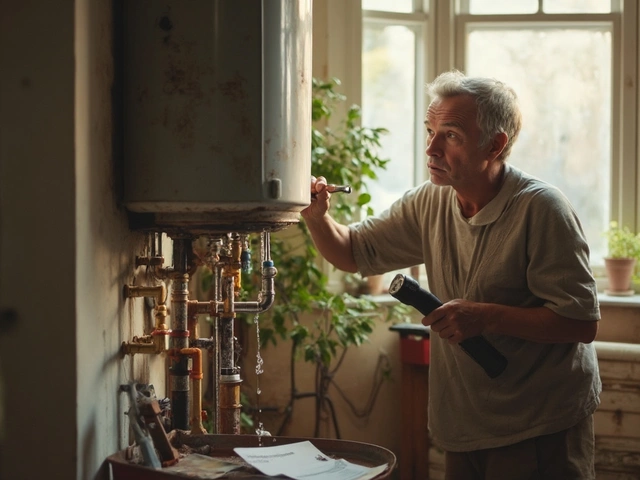Got an old oven that's still the heart of your kitchen? It can keep heating your meals for years if you treat it right. Below are no‑nonsense tips to keep it humming, avoid nasty surprises, and know when to call a professional.
Even a quick glance each day can catch small issues before they turn into big repairs. Open the door after each use and look for burnt crumbs or spills. Wipe them away while the oven is still warm – the heat helps loosen food, and you prevent smoke or nasty odors later.
Next, check the door seal. A ragged gasket lets heat escape, making the oven work harder and raising your energy bill. Run a fingertip along the edge; if you feel a draft, it’s time to replace the seal.
Once a month, give the oven a thorough clean. Remove racks and soak them in warm, soapy water. For the interior, avoid harsh chemicals; a paste of baking soda and a little water works wonders. Let it sit for 15 minutes, then wipe clean with a damp cloth. This removes built‑up grease that can cause uneven heating.
While you’re at it, inspect the heating element. Look for cracks, blistered spots, or blackening. A damaged element can cause cold spots or make the oven refuse to heat altogether. If you spot any damage, note the part number (usually printed on the element) and order a replacement.
Old ovens often have a simple thermostat that can drift over time. Test it by placing an oven‑safe thermometer inside and comparing the reading to the set temperature. If you’re off by more than 15°C, the thermostat may need recalibration or replacement.
Don’t forget the vent and fan (if your model has one). Dust and lint can clog them, reducing airflow and causing the oven to overheat. Use a soft brush or vacuum the vents gently every few months.
Safety matters. Always disconnect power before you touch any internal parts. If you’re unsure about wiring, it’s better to let a qualified electrician or a Bognor Regis Appliance Repair Expert handle it. A mis‑wired oven can be a fire hazard.
When you spot a problem you can’t fix, weigh the cost of repair against buying a new oven. A typical repair for an element or thermostat runs between £80‑£150. If the oven is more than 15‑20 years old and parts are hard to find, replacement might make more sense.
However, many old ovens have solid metal bodies that outlast cheap new models. A well‑maintained vintage cooker can be more reliable and even add character to your kitchen. Think of it as an investment: a bit of regular care saves you from pricey breakdowns.
If you need a professional opinion, give Bognor Regis Appliance Repair Experts a call. Their technicians know how to diagnose old ovens, source hard‑to‑find parts, and fix issues quickly. They’ll also give you a clear estimate before any work starts.
Bottom line: a clean, well‑sealed, and regularly inspected oven stays efficient and safe. Simple daily habits, monthly deep cleaning, and occasional checks on the element and thermostat keep your old oven performing like new. When in doubt, trust a local pro to keep the heat flowing without a hassle.

Wondering if your 20-year-old oven can be repaired? Discover repair tips, replacement part insights, costs, and when it makes sense to swap your old oven for a new one.

Wondering what an appliance job really is? This article breaks down everything you need to know, from common types of jobs to what actually happens when a technician shows up at your door. You'll learn when to call for help, what to expect during a service visit, and how to get the best results for your money. Get practical tips before you book, so there are zero surprises. Whether it’s your fridge, washer, or oven acting up, this guide has your back.

Learn how to spot a malfunctioning heat pump, recognize warning signs early, and troubleshoot issues to keep your home comfortable and energy bills in check.

Microwave suddenly dead? It might be the fuse. This article breaks down the real cost of repairing a microwave fuse—parts, labor, hidden fees, and whether you should DIY. You'll get practical tips on when to call a pro, what brands cost more, and how to avoid common mistakes. A straightforward guide to help you fix your microwave without overspending.

Resetting a freezer compressor may sound daunting, but it's an essential skill for maintaining your appliance's efficiency. Compressors can occasionally need a reset to function properly, potentially saving you from costly repairs or replacements. This article walks you through the steps to safely reset your freezer compressor and offers tips to prevent future issues. Understanding when and why to reset your compressor can keep your freezer running smoothly and extend its lifespan.

Wondering if your hot water heater is about to quit? This article breaks down the most common signs that your water heater needs to be replaced, from strange noises to rusty water. Find out how long these tanks usually last, what to look for during regular maintenance, and how to handle sudden issues. You'll get practical tips to keep your heater running smoothly and avoid a cold shower surprise. If you've ever worried about flooding, energy bills, or weird knocking, this is for you.